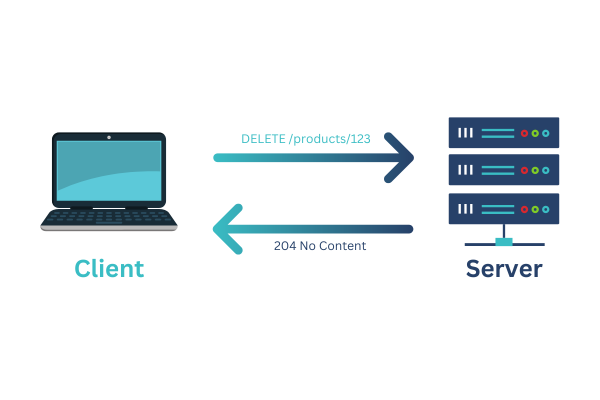In the realm of RESTful APIs (Representational State Transfer Application Programming Interfaces), the DELETE method in REST API is your trusty tool for removing resources from the server. Think of it as the digital equivalent of hitting the “delete” key on your keyboard – but with greater precision and control.
This comprehensive guide will walk you through the ins and outs of the DELETE method, explaining its role, structure, common use cases, and best practices to ensure your APIs handle deletions seamlessly.
Table of Contents
What is the DELETE Method in REST APIs?
The DELETE method is an HTTP verb that instructs the server to remove a specific resource identified by its unique endpoint (URI). It’s a crucial part of the CRUD (Create, Read, Update, Delete) operations that REST APIs commonly support.

Anatomy of a DELETE Request
A typical DELETE request includes:
- HTTP Verb: DELETE
- Endpoint (URI): The specific resource’s location (e.g.,
/products/123to delete a product with ID 123). - Headers (Optional): May include authentication tokens, content-type specifications, or other metadata.
- Request Body: Usually empty, as the resource identifier in the endpoint is sufficient to determine what to delete.
Understanding DELETE Responses
A successful DELETE request typically results in one of two HTTP status codes:
- 204 No Content: Indicates the resource was successfully deleted, and no further content is necessary in the response.
- 200 OK: Indicates success, and the response body may optionally include details about the deletion or the state of the resource before deletion.
Error responses might include:
- 404 Not Found: The requested resource was not found.
- 400 Bad Request: The request was malformed or invalid.
Common Use Cases for DELETE method in REST APIs
- E-commerce: Deleting products, orders, or customer accounts.
- Social Media: Removing posts, comments, or user profiles.
- Content Management: Deleting blog posts, pages, or media files.
- Resource Management: Removing cloud resources, virtual machines, or database records.
DELETE Method Best Practices
- Clear Identification: Ensure that the endpoint accurately and uniquely identifies the resource to be deleted.
- Idempotence: Design your DELETE method to be idempotent, meaning that multiple identical requests have the same effect as one.
- Confirmation (Optional): For critical deletions, consider adding a confirmation step to prevent accidental data loss.
Example: Deleting a Product
DELETE /api/products/12345Cautions and Security Considerations
- Data Loss: DELETE requests are permanent. Always exercise caution to avoid accidental data loss. Regularly back up your data and consider implementing a soft delete feature (marking data as deleted but not immediately removing it) to allow for recovery if needed.
- Authorization: Implement proper authentication and authorization mechanisms to ensure that only authorized users can delete resources. Use industry-standard techniques like OAuth2, JWT (JSON Web Tokens), or API keys to control access.
- Validation: Thoroughly validate all input parameters in DELETE requests to prevent malicious actors from attempting to delete unintended resources or manipulating your API.
- Rate Limiting: Implement rate limiting to prevent excessive DELETE requests that could overload your server or result in denial-of-service (DoS) attacks.
- Logging: Maintain comprehensive logs of DELETE operations to track who deleted what and when, aiding in troubleshooting and security audits.
FAQs: DELETE Method in REST APIs
Is DELETE the only method to remove data from a REST API?
While DELETE is the standard for removing resources, some APIs might use POST with a specific action to handle deletions.
Can I undo a DELETE operation?
In most cases, no. DELETE requests are designed to be permanent. It’s essential to have backup and recovery mechanisms in place for critical data.
How do I test DELETE requests?
You can use tools like Postman, Insomnia, or cURL to send DELETE requests to your API and verify the response.
What happens if I send a DELETE request to a non-existent resource?
A: Typically, the server will respond with a 404 Not Found status code.
Should I always use the 204 No Content status code for successful deletions
While 204 is preferred, you might use 200 OK if you want to provide additional information in the response body.